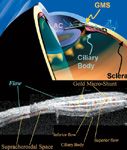Article
Gold microshunt implantation may be an option for lowering IOP
Chicago—Glaucoma patients whose condition is nonresponsive to traditional therapies may have another treatment option, the gold microshunt (GMS) from SOLX. Outcomes of a study of the novel implant placed in the supraciliary space, which were conducted at sites in Israel and Spain, showed that 61% of patients had achieved IOP reduction of 30% or more by 6 months, with a mean reduction of 34% at 18 months after implantation.

"The outcome so far looks very promising," said Shlomo Melamed, MD, director of the Sam Rothberg Glaucoma Center, Goldschleger Eye Institute at Sheba Medical Center, Tel-Hashomer, Israel, one of the principal investigators. More than 70 cases have been performed, and investigators are very encouraged by the results, he added.
In the study presented in a poster at the American Academy of Ophthalmology annual meeting, unpaired glaucomatous eyes of 60 patients, ages 23 to 85, had the GMS implanted. The mean preoperative IOP was 27.72 mm Hg (n = 60), and the mean postoperative IOP at 18 months was 18.38 mm Hg (n = 8). The IOP reduction attained with the GMS stabilized at 6 weeks and reached 34% at 18 months.
All cases involved refractory glaucoma, and most patients had already undergone various procedures, such as trabeculectomy, implantation of an Ahmed valve, or laser cyclophotocoagulation.
During the follow-up phase of the study, patients received an ocular examination and Goldmann applanation tonometry at 24 hours, 1 week, 2 weeks, 3 weeks, 6 weeks, 3 months, 6 months, 12 months, and 18 months. An ultrasound study was performed within 1 week of surgery to verify that the GMS was properly positioned in the supraciliary space.

In addition, a bench flow study was conducted using an artificial anterior chamber, and ADINA finite-element software was used to model the GMS' flow resistance and verify results of the flow test. In bench testing, the GMS flow resistance was similar to the simulated resistance.
All eyes tolerated the shunt well, and the procedure was easy to perform. "We did not see severe complications," Dr. Melamed said. "We were afraid at the beginning that dissection just above the ciliary body into the supraciliary space would be associated with bleeding and suprachoroidal hemorrhage. That has not happened in any of the cases so far. The eyes are very quiet. Immediately after the operation it looks as if the eyes had not been operated on because apparently the eye can tolerate the gold very nicely."
Seven cases of transient hypotony and 18 cases of transient hyphema occurred, all of which were less than 2 mm and resolved without further complications. One case of shunt extrusion was reported due to improper placement.




